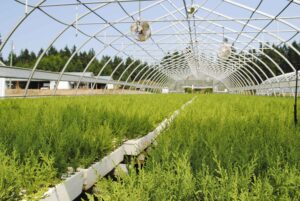 Cast a look across the horizon of the recently minted year 2023 and it looks too much like 2022 to inspire much confidence. …The list of familiar issues for the forest industry includes sawlog availability, rising operating costs, continuing skilled labour shortages and the faltering lumber markets in Asia along with a characteristically belligerent market in the United States. …But this year can be different. The timing is right for B.C.’s NDP government to start talking frankly about its intentions to the provincial forest sector. …The present B.C. government has the same troubling tendencies of many of its predecessors. It tends to listen to whichever self interest group is attracting the public’s attention and—in the case of the forest industry—frame its land use decision-making accordingly.
Cast a look across the horizon of the recently minted year 2023 and it looks too much like 2022 to inspire much confidence. …The list of familiar issues for the forest industry includes sawlog availability, rising operating costs, continuing skilled labour shortages and the faltering lumber markets in Asia along with a characteristically belligerent market in the United States. …But this year can be different. The timing is right for B.C.’s NDP government to start talking frankly about its intentions to the provincial forest sector. …The present B.C. government has the same troubling tendencies of many of its predecessors. It tends to listen to whichever self interest group is attracting the public’s attention and—in the case of the forest industry—frame its land use decision-making accordingly.
The time is right for a new model for managing B.C.’s forests; one that reflects new thinking to complement the world’s new realities. For example, the provincial government, First Nations and the forest industry could work co-operatively to identify, designate and protect areas of provincial land as part of a working forest. …A working forest designation would provide a solid platform for industry re-organization to occur. It could also usher in a different approach to forest management… [it] could well prove a literal lifeline for many forest industry-reliant communities… [it] could also help sweep away some uncertainties surrounding investment in the B.C. …A working forest model could encourage more intensive management techniques to better suit the needs of a specific area. The B.C. government would benefit from the establishment of a working forest in ways beyond a better managed forest land base.

 From timber long houses in Europe to temples in Asia, wood has been a primary construction material in buildings since the Stone Age, with some still standing more than a thousand years later. Today, modern technology and engineering is turning wood into a “new” building material, mass timber, which is set to transform the North American lumber industry. …For decades, Europe has been at the forefront of this revolution, but growing momentum in the still-nascent North American market is fostering an environment ripe for commercial opportunities. …The number of North American mass timber plants has grown to 22 from just 4 in 2016, and that number could more than double by 2027… and there are many opportunities to participate in different parts of the business. These include fabrication of and design services for the various components and connections, all the way to working with architects and engineers on fully integrated design and supply solutions.
From timber long houses in Europe to temples in Asia, wood has been a primary construction material in buildings since the Stone Age, with some still standing more than a thousand years later. Today, modern technology and engineering is turning wood into a “new” building material, mass timber, which is set to transform the North American lumber industry. …For decades, Europe has been at the forefront of this revolution, but growing momentum in the still-nascent North American market is fostering an environment ripe for commercial opportunities. …The number of North American mass timber plants has grown to 22 from just 4 in 2016, and that number could more than double by 2027… and there are many opportunities to participate in different parts of the business. These include fabrication of and design services for the various components and connections, all the way to working with architects and engineers on fully integrated design and supply solutions.

 This presents the opportunity for both the lumber and pulp industries to co-operate on land management, sharing in the carbon offset credit revenue to help pay for the establishment of the plantation, while benefiting from additional fibre sources over a shorter time span. …There is plenty of room in Canada for both conventional crop farming and tree farming. The key is to plan strategically and aim, for example, at productive land parcels that are difficult to farm but could still generate income through the sale of carbon offset credits. Parcels as small as one hectare could still be monetized into a valuable tree farm. …If Canada wants to achieve its GHG reduction targets, it’s going to have to do a lot more than just pump carbon dioxide back into the ground… and making tree farming affordable goes a long way toward building a natural climate change solution.
This presents the opportunity for both the lumber and pulp industries to co-operate on land management, sharing in the carbon offset credit revenue to help pay for the establishment of the plantation, while benefiting from additional fibre sources over a shorter time span. …There is plenty of room in Canada for both conventional crop farming and tree farming. The key is to plan strategically and aim, for example, at productive land parcels that are difficult to farm but could still generate income through the sale of carbon offset credits. Parcels as small as one hectare could still be monetized into a valuable tree farm. …If Canada wants to achieve its GHG reduction targets, it’s going to have to do a lot more than just pump carbon dioxide back into the ground… and making tree farming affordable goes a long way toward building a natural climate change solution. One of my biggest pet peeves is the misguided expectations that come from using the number of jobs per thousand cubic metres of timber harvested to compare British Columbia’s forest sector to other jurisdictions. Critics have attempted to associate BC’s comparatively low generation of jobs per thousand cubic metres harvested to issues such as log exports, mechanization, forest management practices and minimal value-added processing. …BC is often compared to Quebec and Ontario, which have much higher jobs per thousand cubic metres harvested. …Jobs per thousand cubic metres of timber harvested is a relative metric useful for comparison to other regions, but it does not tell the behind-the-scenes story.
One of my biggest pet peeves is the misguided expectations that come from using the number of jobs per thousand cubic metres of timber harvested to compare British Columbia’s forest sector to other jurisdictions. Critics have attempted to associate BC’s comparatively low generation of jobs per thousand cubic metres harvested to issues such as log exports, mechanization, forest management practices and minimal value-added processing. …BC is often compared to Quebec and Ontario, which have much higher jobs per thousand cubic metres harvested. …Jobs per thousand cubic metres of timber harvested is a relative metric useful for comparison to other regions, but it does not tell the behind-the-scenes story.  North American lumber markets continue to strengthen from ongoing logistical problems and supply chain woes. …SPF mills in BC continue to face railcar shortages… and now the Russia- Ukraine invasion threatens lumber exports from the world’s largest exporter. This event will only tighten up the world’s lumber supplies and push prices even higher, especially in Europe. …US lumber and panel demand continues to advance, spurred on by COVID-19 constraints and steady demand for new homes. US housing starts continue to move higher and reached 1.597 million units in 2021, a 15.8 per cent increase from 2020. However, a slower rate of new house construction is forecast for 2022 (+3 to 5 per cent) as builders simply cannot build houses fast enough. …US repair and remodelling activity accounts for 40 per cent of US lumber consumption and it is expected to increase significantly again in 2022.
North American lumber markets continue to strengthen from ongoing logistical problems and supply chain woes. …SPF mills in BC continue to face railcar shortages… and now the Russia- Ukraine invasion threatens lumber exports from the world’s largest exporter. This event will only tighten up the world’s lumber supplies and push prices even higher, especially in Europe. …US lumber and panel demand continues to advance, spurred on by COVID-19 constraints and steady demand for new homes. US housing starts continue to move higher and reached 1.597 million units in 2021, a 15.8 per cent increase from 2020. However, a slower rate of new house construction is forecast for 2022 (+3 to 5 per cent) as builders simply cannot build houses fast enough. …US repair and remodelling activity accounts for 40 per cent of US lumber consumption and it is expected to increase significantly again in 2022. 





 There are many times when I’ve been frustrated by the headlines sensationalizing protests about forest management in BC. The relentlessness of the attacks on our forest sector becomes, right or wrong, numbing. …I’m not talking about the legal and passionate protests and dialogue about the future of forest management in BC. This is about those that flout the law, discourage real discussion, discourage democracy, and have a new brand of colonialism. One protest group dumped a pile of manure at the front door of Premier Horgan’s constituency office. Wow, that is really mature. Next, Minister Conroy’s home phone number was published online and both she and her family members received threatening messages. Wow, what kind of person does that?
There are many times when I’ve been frustrated by the headlines sensationalizing protests about forest management in BC. The relentlessness of the attacks on our forest sector becomes, right or wrong, numbing. …I’m not talking about the legal and passionate protests and dialogue about the future of forest management in BC. This is about those that flout the law, discourage real discussion, discourage democracy, and have a new brand of colonialism. One protest group dumped a pile of manure at the front door of Premier Horgan’s constituency office. Wow, that is really mature. Next, Minister Conroy’s home phone number was published online and both she and her family members received threatening messages. Wow, what kind of person does that?


 Last year BC exported over $16.3 billion of forest products… But will BC forestry and the workers, communities, First Nations and professionals in this sector continue to be a robust part of our economy as it has been for more than a century? The NDP government recently tabled ideologically-driven plans to damage the forest sector, perhaps irreparably. Their plans needs a sober second look and major rethink. These radical, unprecedented proposals were dropped on rural BC communities, forest workers, unions, forest professionals, First Nations, the forestry industry and 10,000 BC businesses supported by forestry. In my 50 years’ experience working in our forests, it’s hard to fathom why so little consultation was done with those most affected.
Last year BC exported over $16.3 billion of forest products… But will BC forestry and the workers, communities, First Nations and professionals in this sector continue to be a robust part of our economy as it has been for more than a century? The NDP government recently tabled ideologically-driven plans to damage the forest sector, perhaps irreparably. Their plans needs a sober second look and major rethink. These radical, unprecedented proposals were dropped on rural BC communities, forest workers, unions, forest professionals, First Nations, the forestry industry and 10,000 BC businesses supported by forestry. In my 50 years’ experience working in our forests, it’s hard to fathom why so little consultation was done with those most affected.



 Saskatchewan has always been a sleeping giant in terms of its contribution to the Canadian forest industry, despite its massive and mature—though seriously under-utilized—forest resource. But it seems that the giant has now finally awakened. In a flurry of press releases over the span of a week, the province announced a reallocation of its forest resource primarily located north of Saskatoon that will result in significant forest industry investment. It includes a huge sawmill expansion by Dunkley Lumber in Carrot River, Carrier Forest Products ramping up production in Big River, a OSB plant for Prince Albert by new business venture, One Sky Forest Products, and the re-opening of the geographically iconic pulp mill located north of Prince Albert, now owned by Paper Excellence. All told, it will result in over $1 billion in new investment over two years.
Saskatchewan has always been a sleeping giant in terms of its contribution to the Canadian forest industry, despite its massive and mature—though seriously under-utilized—forest resource. But it seems that the giant has now finally awakened. In a flurry of press releases over the span of a week, the province announced a reallocation of its forest resource primarily located north of Saskatoon that will result in significant forest industry investment. It includes a huge sawmill expansion by Dunkley Lumber in Carrot River, Carrier Forest Products ramping up production in Big River, a OSB plant for Prince Albert by new business venture, One Sky Forest Products, and the re-opening of the geographically iconic pulp mill located north of Prince Albert, now owned by Paper Excellence. All told, it will result in over $1 billion in new investment over two years.

